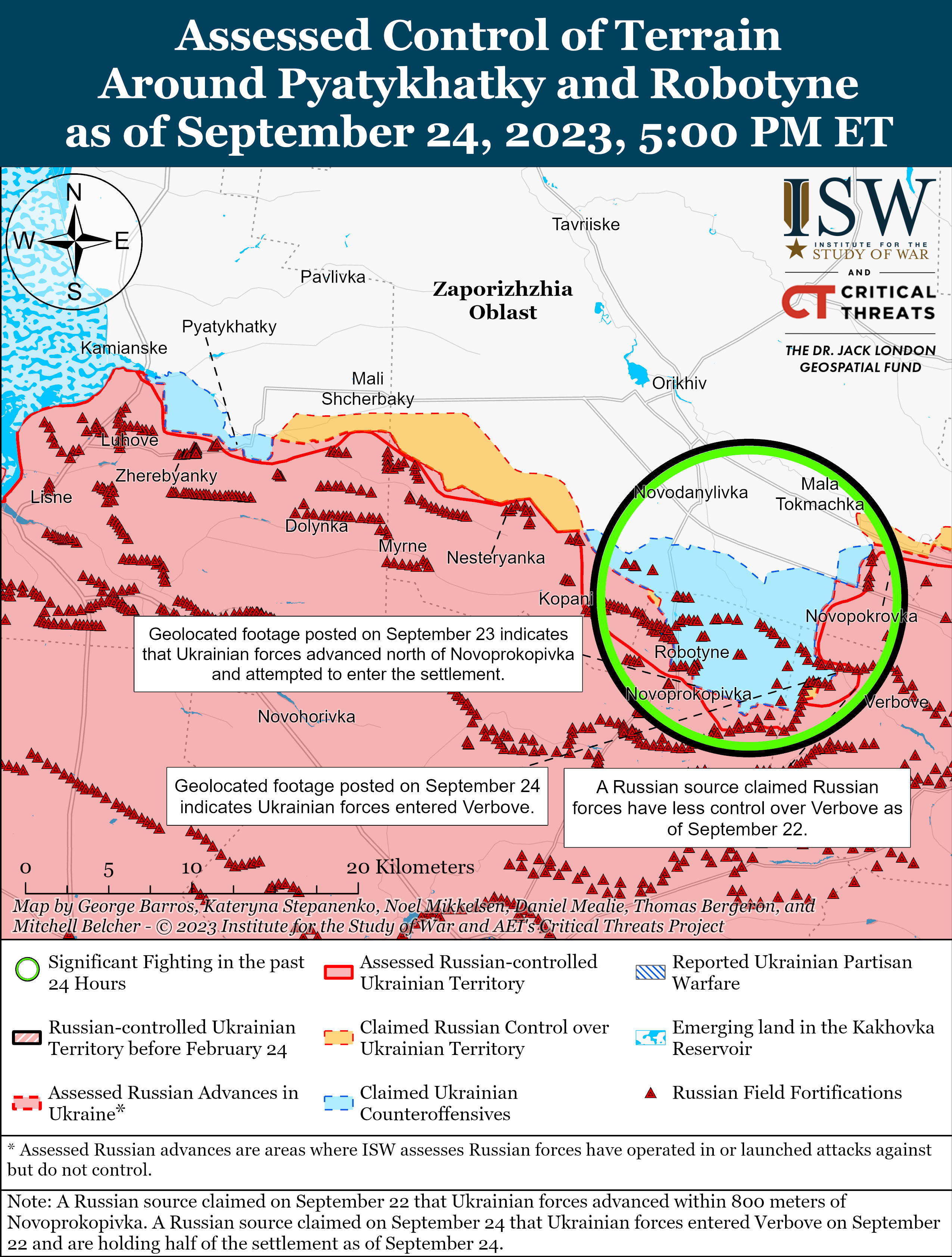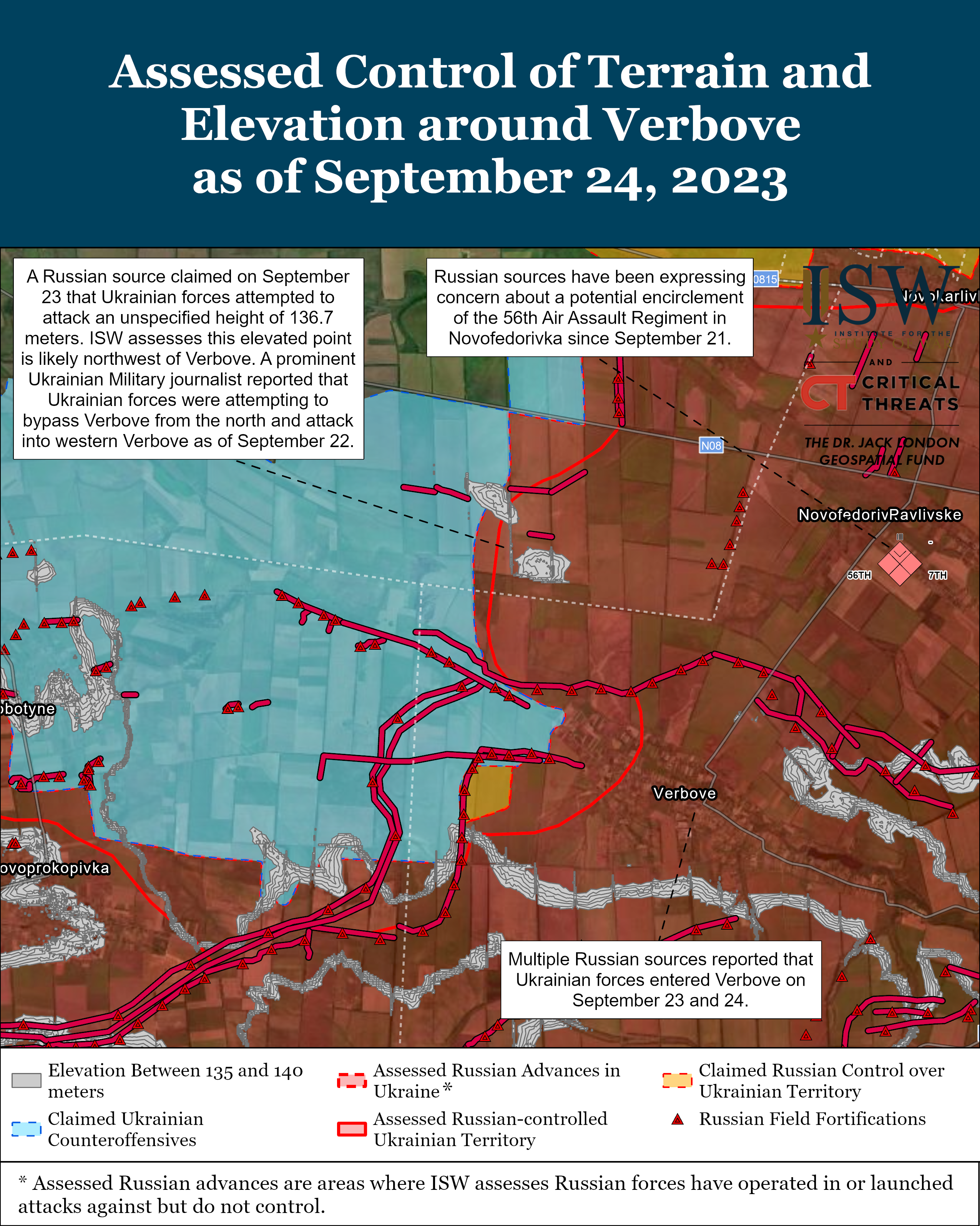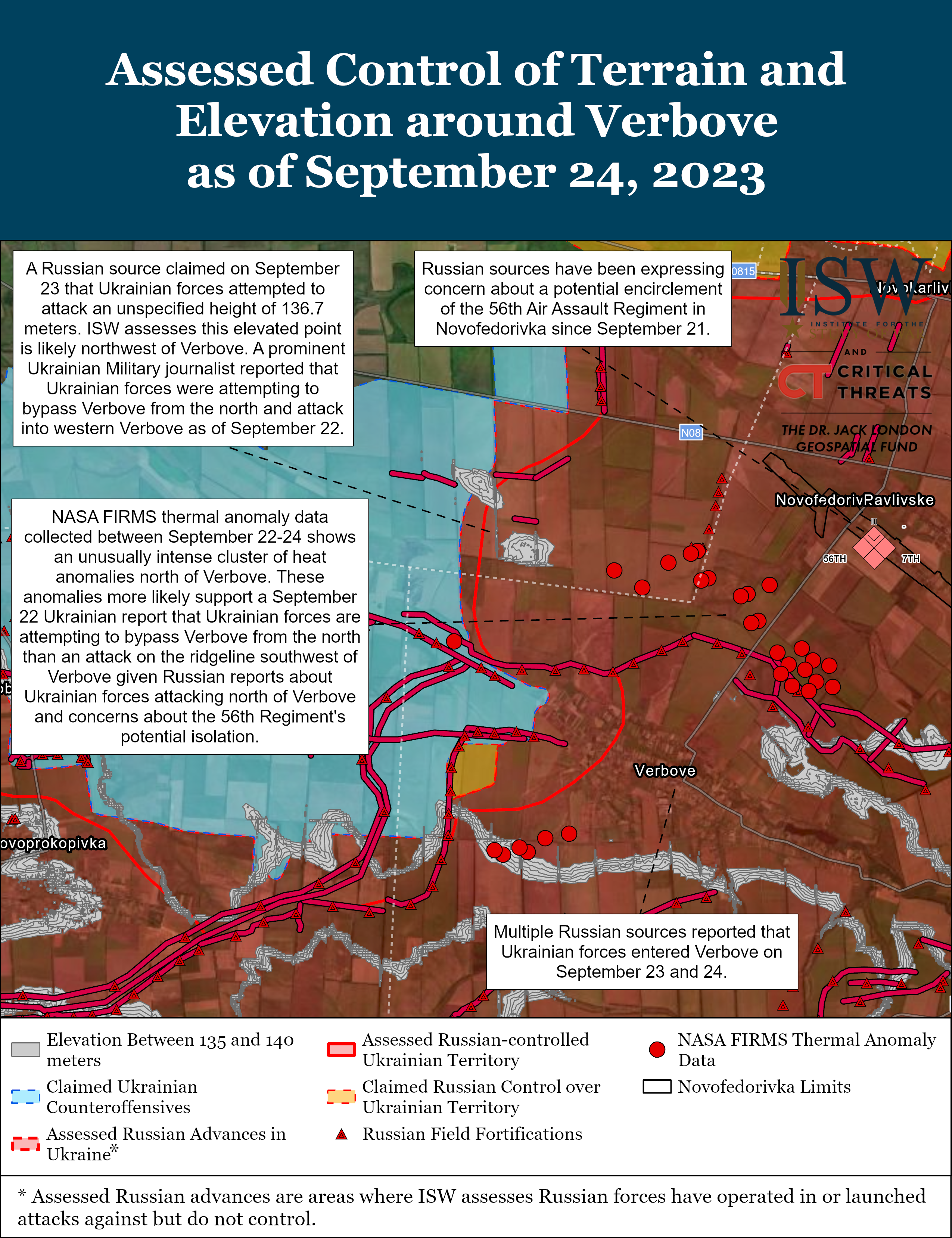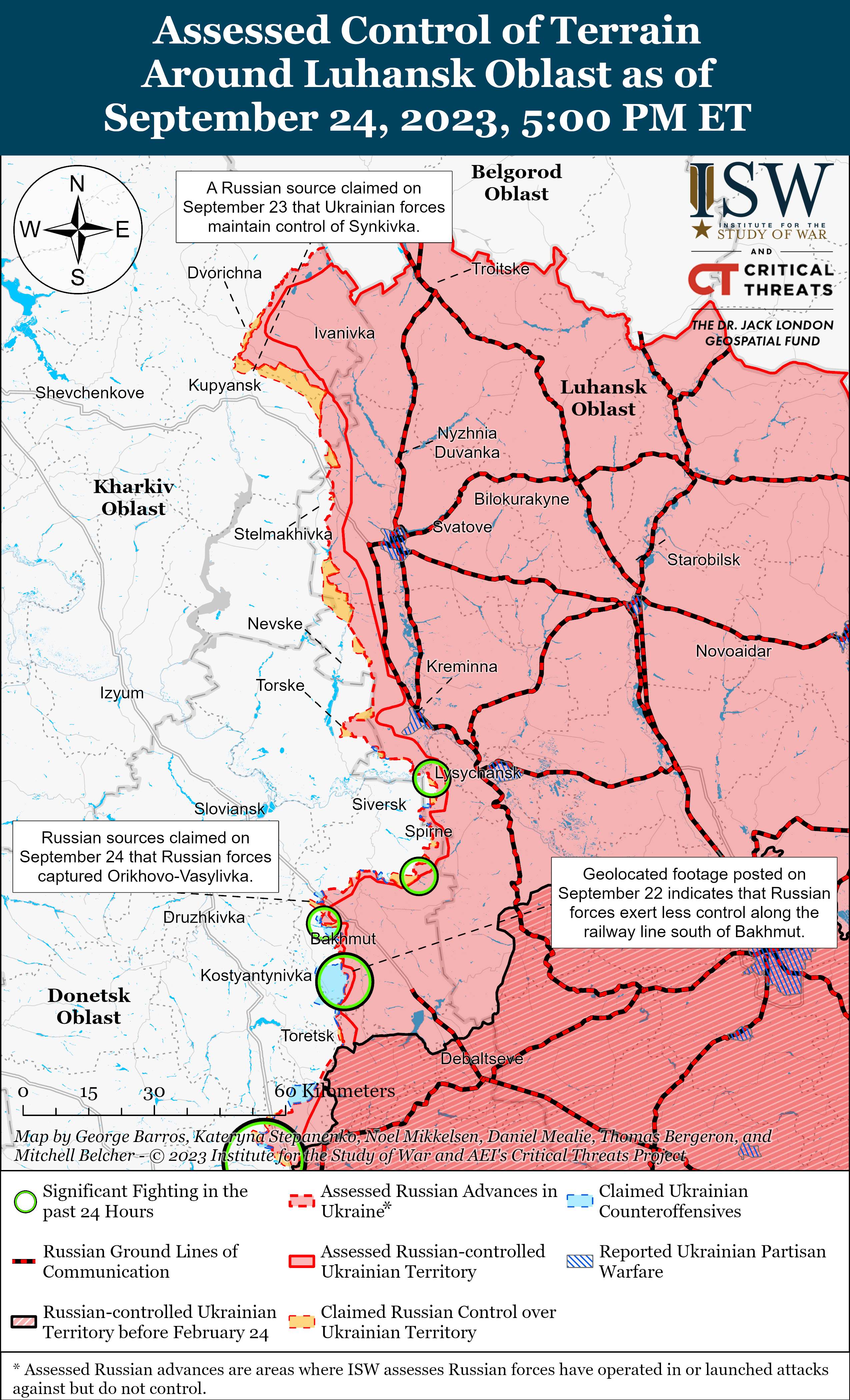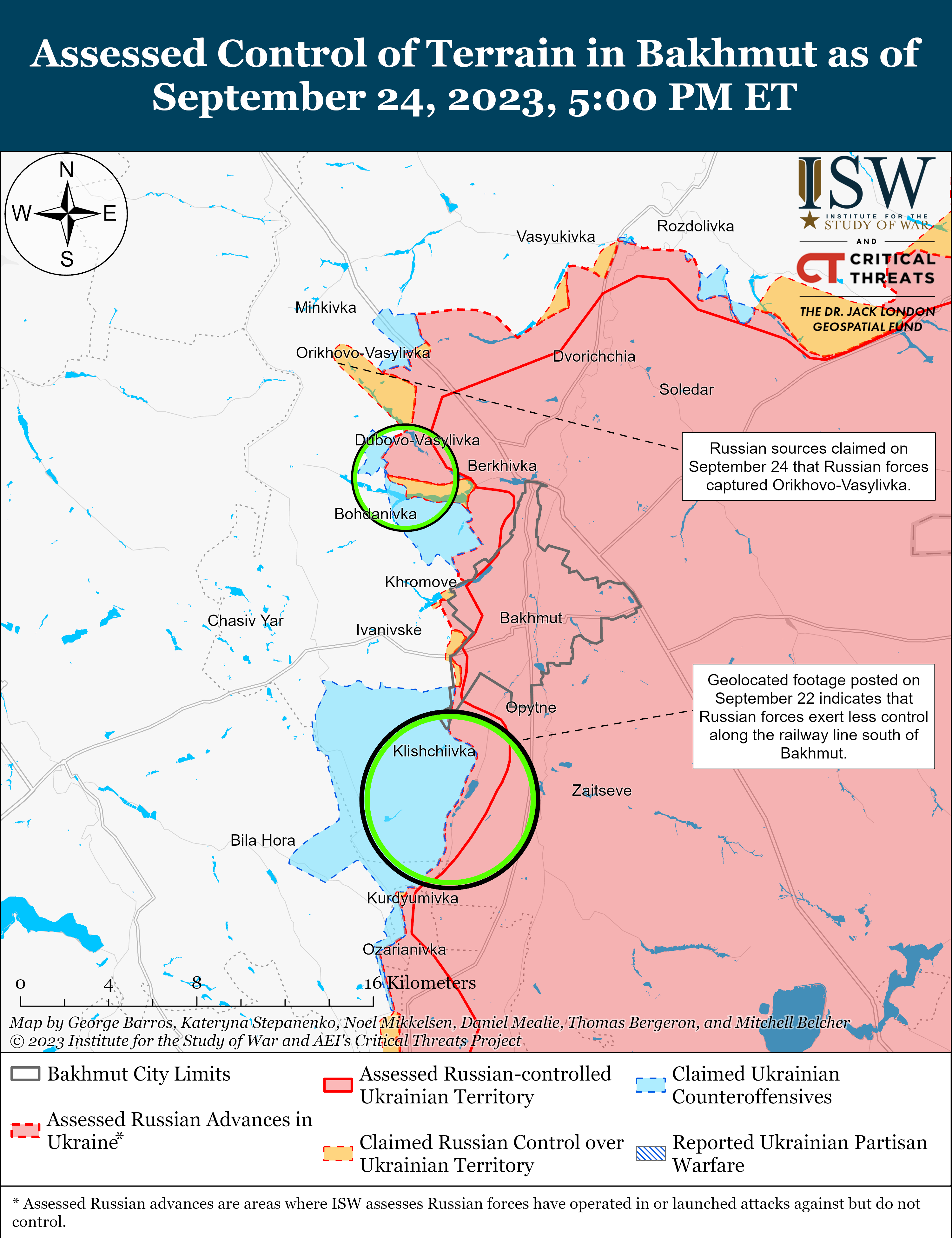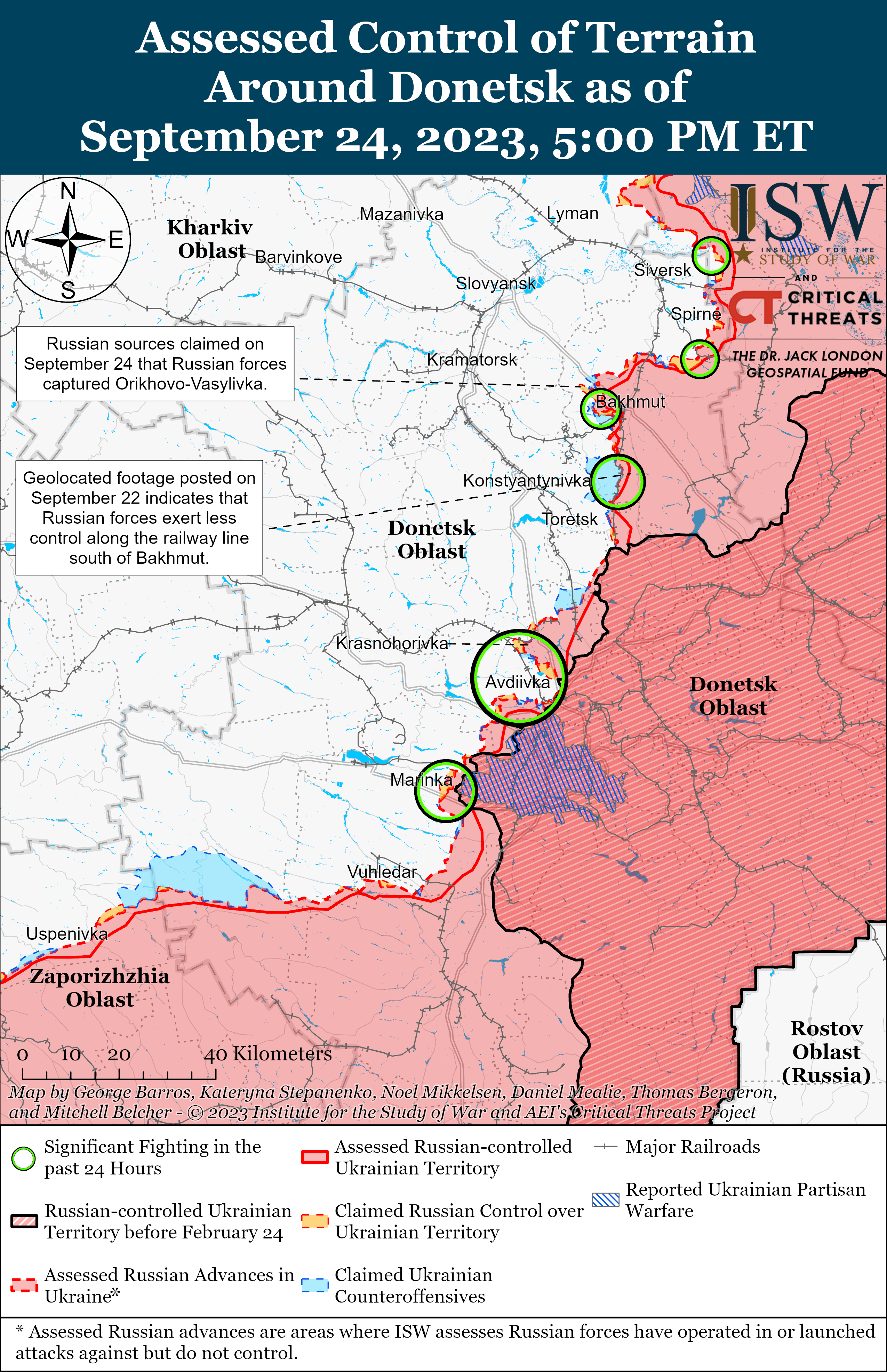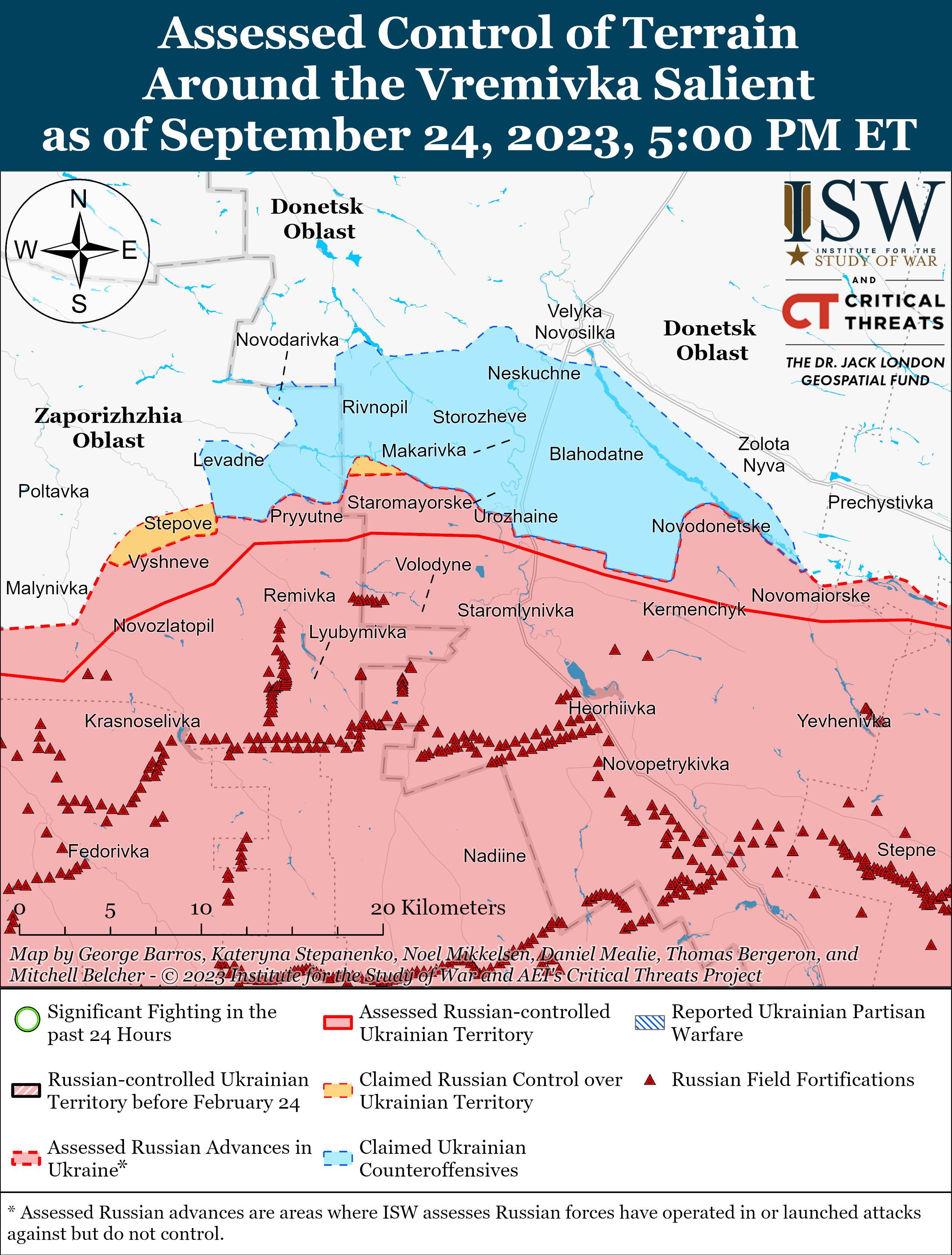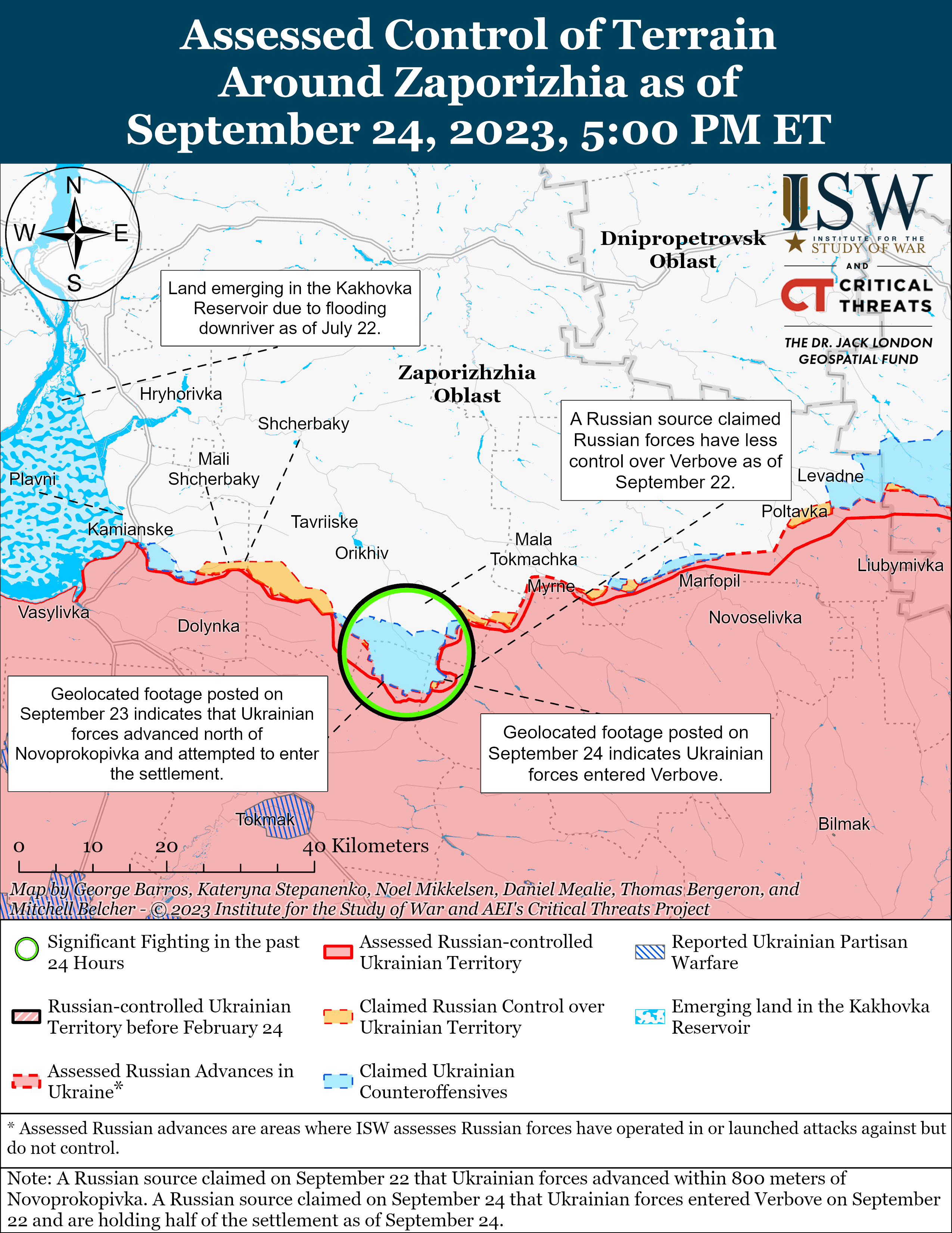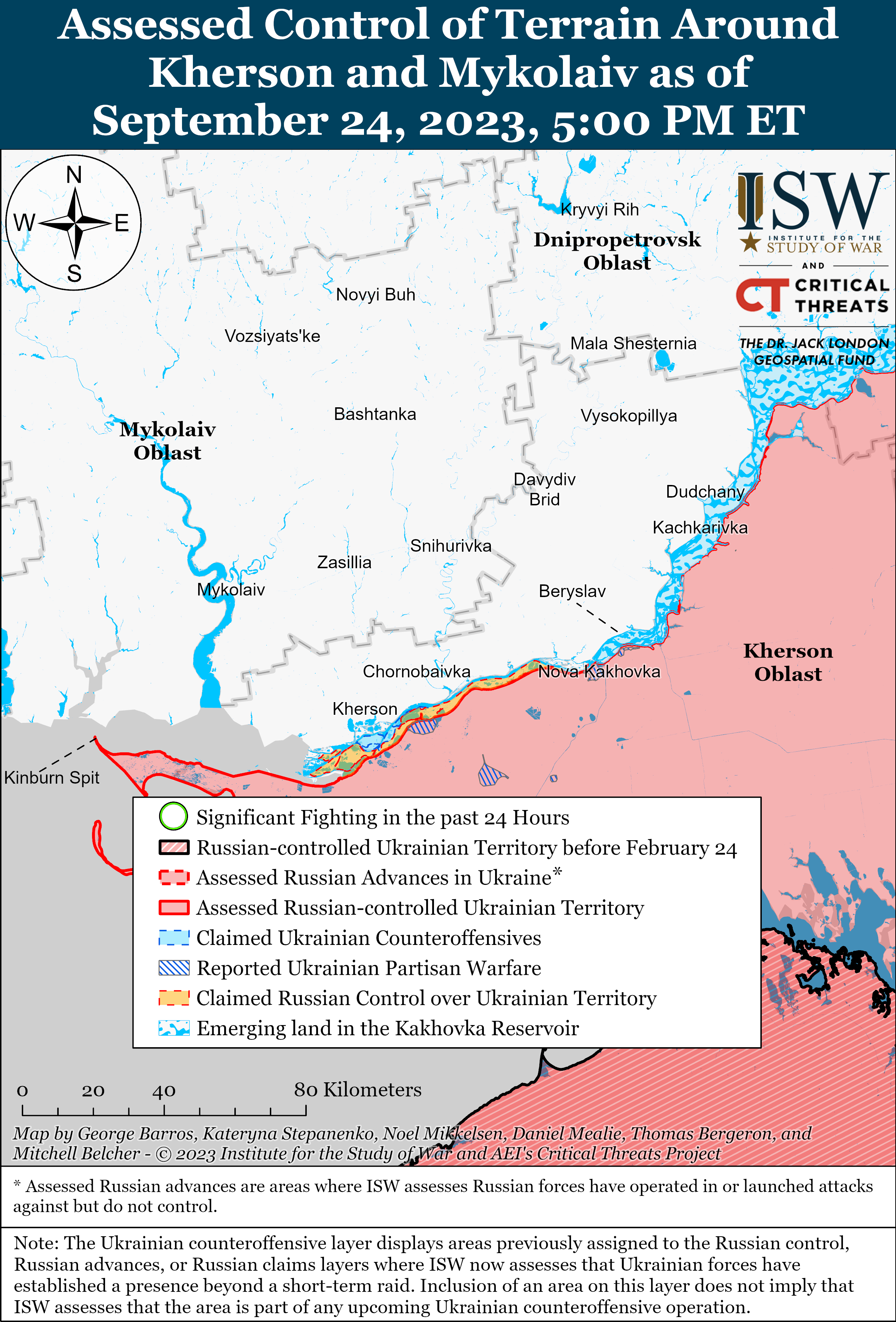 |
 |
Russian Offensive Campaign Assessment, September 24, 2023

Russian Offensive Campaign Assessment, September 24, 2023
George Barros, Kateryna Stepanenko, Riley Bailey, Angelica Evans, and Frederick W. Kagan
September 24, 2023, 9:00 pm ET
Click here to see ISW’s interactive map of the Russian invasion of Ukraine. This map is updated daily alongside the static maps present in this report.
Click here to access ISW’s archive of interactive time-lapse maps of the Russian invasion of Ukraine. These maps complement the static control-of-terrain map that ISW produces daily by showing a dynamic frontline. ISW will update this time-lapse map archive monthly.
Note: The data cut-off for this product was 3pm ET on September 24. ISW will cover subsequent reports in the September 25 Russian Offensive Campaign Assessment.
ISW is providing an assessment of a very dynamic situation in the ongoing Ukrainian counteroffensive near Orikhiv in western Zaporizhia Oblast. ISW emphasizes that the situation remains dynamic and unclear and that the tactical situation is likely changing rapidly. It is too early to forecast if Ukrainian forces will achieve an operational breakthrough in this sector of the front.
Elements of three Russian divisions are actively defending against Ukrainian assaults around the Ukrainian salient in the Orikhiv area in western Zaporizhia Oblast. Elements of the Russian 42nd Motorized Rifle Division (58th Combined Arms Army, Southern Military District) are deployed and are defending at the southernmost point of the Ukrainian penetration and are engaging Ukrainian forces in Novoprokopivka (13km south of Orikhiv).[1] Elements of the Russian 76th Air Assault Division deployed to the Ukrainian salient’s western flank near Kopani (11km southwest of Orikhiv) towards Robotyne (10m south of Orikhiv) and are counterattacking there.[2] Elements of the 7th Air Assault Division are deployed on the Ukrainian salient‘s eastern flank near the Verbove-Novopokrovka line and are counterattacking there.[3] Sources affiliated with the Russian Airborne (VDV) Forces report that the 56th Air Assault Regiment (7th Air Assault Division) is deployed about 5km north of Verbove near Novofedorivka.[4]
A Russian source claimed that the 7th and 76th VDV Divisions were ordered to conduct an operational encirclement of the Ukrainian salient, but that they failed to do so and that the 7th VDV Division’s effectiveness significantly declined after a successful Ukrainian strike against the division headquarters on September 19.[5] ISW offers no assessment about these reported orders to encircle Ukrainian forces beyond noting that it would be a sound practice for Russian forces to conduct counterattacks against Ukrainian forces’ flanks within limits.
Ukrainian forces are attacking along three directions within the Orikhiv salient as of September 24. Ukrainian forces are conducting attacks from Robotyne against Novoprokopivka.[6] Ukrainian forces are attacking directly into Verbove’s western side.[7] Ukrainian forces are also attacking north of Verbove.[8]
Russian sources report that Ukrainian forces broke into Verbove on September 22 and continued attacking the settlement with armored vehicles as of September 24. Geolocated combat footage posted on September 24 shows a Ukrainian BMP operating within Verbove’s westernmost village limits.[9] A VDV-affiliated source reported that Ukrainian forces entered Verbove for the first time on September 22 and continued pushing east.[10] The VDV source later reported that Ukrainian forces occupy half of Verbove as of September 24.[11] The VDV source accused the Russian Ministry of Defense (MoD) of trying to conceal Ukraine’s tactical progress in Verbove, rhetorically stating, “For how long can Shoigu’s MoD hide the breakthrough in Verbove?“[12] Several Russian sources reported on September 24 that Ukrainian forces continue deploying vehicles against Verbove, including Bradley infantry fighting vehicles.[13] Some Russian sources are vehemently denying any Ukrainian breakthrough in Verbove as of September 24.[14] The Ukrainian General Staff reported that Ukrainian forces captured new unspecified locations near Verbove on September 24.[15]
Ukrainian forces are attacking north of Verbove and could isolate the 56th VDV Regiment deployed in Novofedorivka from its sister regiments in the Verbove area according to Russian sources. A Russian VDV source warned that there is a “real threat” of Ukrainian forces reaching the 56th VDV Regiment’s rear near Novofedorivka on September 21.[16] The VDV source warned on September 22 that Ukrainian forces are within 7km of encircling the 56th VDV Regiment and that the regiment would be in a difficult position if its commander did not make a decision to withdraw from Novofedorivka to other previously prepared positions.[17] ISW does not assess that an encirclement of the 56th VDV Regiment is likely, though Ukrainian forces may isolate it from the rest of the 7th VDV Division if Ukrainians manage to outmaneuver it from Verbove’s north and the regiment inexplicably remains in its current positions.
Ukrainian military journalist Konstyantyn Mashovets reported on September 22 that Ukrainian forces are attempting to bypass Verbove from the north.[18] A prominent Kremlin-linked milblogger reported on September 24 that Ukrainian forces improved their positions near Novofedorivka’s flank.[19] Another prominent Russian milblogger reported on September 23 that Ukrainian forces attempted to attack an unspecified tactical height with an elevation of 136.7 meters near Verbove and that Ukrainian forces were deploying vehicles from the north to the south near Verbove.[20] ISW assesses that this tactical height of 136.7 meters is likely located approximately 3.5km northwest of Verbove based on an analysis of digital elevation data around Verbove. (It is customary in militaries to identify locations based on terrain elevations as marked on commonly used military maps, but ISW does not have access to the Russian maps to check for such markings.)
NASA FIRMS/VIIRS thermal anomaly data collected between September 22-24 shows an unusually intense cluster of heat anomalies north of Verbove. These anomalies, while not dispositive, are a supporting indicator of combat north of Verbove and support the Russian and Ukrainian reports of Ukrainian activity between Novofedorivka and Verbove.
ISW cannot assess the extent of this Ukrainian attack north of Verbove and has not collected enough geospatial information to map it confidently at this time.
A Russian source affiliated with the VDV expressed panic at the prospect of significant Ukrainian advances in the Verbove area. A Russian milblogger, whose stated mission is to protect VDV Commander Colonel General Mikhail Teplinsky from removal or arrest, warned on September 22 and 23 that the 56th VDV Regiment was under imminent threat of encirclement following the reported Ukrainian advance into Verbove.[21] The milblogger asserted that the commander of the 56th VDV Regiment was unable to make any decision about withdrawal and called on the Russian Ministry of Defense (MoD) to allow Teplinsky to remedy the situation.[22] The milblogger noted high losses and poor morale among the 56th VDV Regiment and claimed that more than half of the personnel of the 7th and 76th VDV Divisions are mobilized personnel.[23] Other Russian sources, including those with close ties to the VDV, have not yet described the situation in Verbove or among VDV forces as this dire. The Russian milblogger may be exaggerating the situation in the Verbove area to negatively portray the Russian military command and advocate for Teplinsky to have more control over tactical and operational decision-making.
The milblogger compared the poor morale in the 56th VDV Regiment to the general morale of the Soviet military during its invasion of Afghanistan and of the Russian military during its campaign in Chechnya. This level of poor morale may have significant impacts on the Russian defense in the area as relatively elite VDV units appear responsible for conducting counterattacks, which require high morale.[24] It is less likely to affect the operations of units under direct attack, however, unless it reaches the point of causing surrenders, which is unlikely among VDV units even comprised of mobilized personnel.
Russian forces continue to expend significant combat power on counterattacking to hold their current positions and appear to be resisting the operationally sound course of action of falling back to prepared defensive positions further south. The Russian command constructed a multi-echeloned defense in southern Ukraine that would have allowed the Russian command to deploy defending Russian forces in depth throughout subsequent defensive layers. Russian forces have instead expended considerable amounts of manpower, materiel, and effort to hold the forwardmost defensive positions in southern Ukraine and have only withdrawn to subsequent defensive positions at the direct threat of Ukrainian advances.[25] Russian forces’ elastic defense requires that one echelon of Russian forces slows a Ukrainian tactical advance while a second echelon of forces counterattacks to roll back that advance. Counterattacking requires significant morale and relatively high combat capabilities, and the Russian military appears to rely on relatively elite units and formations to counterattack, likely at the expense of these forces’ degradation.[26]
Some Russian and Ukrainian sources have acknowledged that some Russian counterattacks in the wider Robotyne area have been senseless.[27] A defense in depth should afford these units respite from further degradation through withdrawal to a subsequent defensive layer. This withdrawal would allow the Russian command to conserve critical combat power for more operationally significant counterattacks and efforts to attrit attacking Ukrainian forces, although the task of conducting an orderly withdrawal under fire or pursuit is quite challenging and risky. American military analysts Michael Kofman and Rob Lee recently assessed that Russian forces have underutilized the depth of their defense and have yet to execute “a true defense in depth” in which Russian forces trade “space for attrition” and that the Russian command’s decision to defend forward has allowed Ukrainian artillery units to attrit Russian forces.[28] ISW concurs with this assessment. ISW has observed a concerted Ukrainian effort to attrit Russian forces even as Ukrainian forces make significant tactical gains, and the Russian resistance to withdrawing to defensive positions further south is likely compounding the asymmetric attrition gradient Ukrainian forces are trying to create. Russian counterattacks aimed at holding forward positions have been tactically significant, but it remains unclear if these counterattacks will have lasting operational importance.
The Russian military command may be ordering these counterattacks to buy time, but it is unclear how the Kremlin intends to use time bought at such a price. Russian forces appear to be unwilling to surrender tactical areas and are focusing instead on fighting for every meter instead of benefiting from the depth of their prepared defenses. Ukrainian military journalist Konstyantyn Mashovets observed that the Russian military command is achieving its objective of buying more time from these counterattacks but questioned what the Russian military command intends to do with this time.[29] Mashovets argued that the sacrifice of combat-ready forces and assets during defensive operations only makes sense in two situations: if it allows time to organize defensive systems at another prepared line or if it buys time for the organization of a more substantial counterattack or counteroffensive. Mashovets added that both scenarios assume that Russia has additional reserves and the ability to rapidly deploy these reserves to a new defensive line or an operational direction where it plans to carry out a new offensive.[30] Mashovets concluded that regardless of the Russian intent behind buying time, the Russian military command still needs additional reinforcements in the western Zaporizhia direction in addition to forces already concentrated on this frontline for Russian forces’ current counterattacks to be operationally sound.
The Russian sacrifice of combat power to hold every meter may alternatively be intended to support the Kremlin’s informational and hybrid warfare objectives. Russian President Vladimir Putin first acknowledged the start of the Ukrainian counteroffensive on June 9 by emphasizing two key and persistent narratives: that Ukrainian forces will not achieve significant successes due to well-prepared Russian defenses and that the Ukrainian forces are suffering heavy losses in personnel and Western military equipment.[31] Putin and the Kremlin have been framing Russian defensive operations as a major battlefield victory, and persistent Russian counterattacks allow the Kremlin to claim these operations as individual victories amidst the general lack of Russian battlefield advances elsewhere. These efforts likely intend to erode support and trust in Ukrainian forces in Ukraine and the West. Putin may have ordered the Russian military command to hold all Russia’s initial defensive positions to create the illusion that Ukrainian counteroffensives have not achieved any tactical or operational effects despite substantial Western support. This informational undertaking can only succeed in the long run if Russian forces can actually prevent Ukrainian forces from breaking through and liberating large areas, however.
The Russian resistance to ceding ground may also be tied to Russian military commanders’ and officials’ attempts to use the counteroffensive to achieve political goals, or it could result from Putin’s micromanagement. A Kremlin insider source claimed that Putin reportedly gave Russian Defense Minister Sergey Shoigu a deadline of one month until early October 2023 to improve the situation on the frontlines, stop Ukrainian counteroffensives, and have Russian forces regain the initiative to launch an offensive operation against a larger city.[32] The insider‘s claim, if true, may indicate that the Russian military command may be ordering relentless counterattacks in hopes of forcing the Ukrainian counteroffensive to culminate, even at a high cost to Russian military capabilities. ISW has previously observed instances in which the Russian MoD, fearing the imminent loss of Putin’s favor, intensified its efforts to purge commanders who offered honest but negative views and advice and pursued unachievable military objectives at the expense of Russian forces.[33] The Russian MoD, for example, launched an unsuccessful and costly offensive on Vuhledar in February 2023 to undermine the domestic Russian informational effects of the Wagner Group’s progress in Bakhmut and maintain favor with Putin.[34] Russian insider sources and milbloggers who have advocated for Teplinsky claimed that Shoigu has been focusing on setting conditions to convince Putin to remove Teplinsky from command – which would likely be achievable if Shoigu is able to achieve Putin’s objectives during the counteroffensive.[35] One pro-Teplinsky channel even claimed that Chief of the Russian General Staff Army General Valery Gerasimov had already removed Teplinsky from overseeing the defensive operation in southern Ukraine, although ISW cannot confirm the validity of this claim at this time.[36]
Ukrainian forces may be able to achieve an operationally significant breakthrough in the southern frontline if several key assumptions hold. A significant Ukrainian success will be more likely if:
- Russian forces do not have the necessary reserves or combat power to maintain Russian defenses in western Zaporizhia Oblast;
- Ukrainian forces retain enough combat power to continue pushing after exhausting Russian combat power; and
- Russian defensive positions behind the current battle area are not as heavily mined or well prepared as the fortifications that Ukrainian forces have breached.
This hypothesis is invalid if any of these assumptions are invalidated. There are indicators that these assumptions remain valid as of this writing. ISW continues to assess that the Russian military does not have sufficient forces deployed to western Zaporizhia Oblast to completely man its defenses in depth and that Ukrainian forces should be able to operate through Russian field fortifications more rapidly if they are not properly manned.[37] Ukraine’s operations in Bakhmut have kept Russian forces committed to eastern Ukraine and away from the southern front and helped deny the creation of a strategic reserve.[38] Ukrainian Main Military Intelligence Directorate (GUR) Head Lieutenant General Kyrylo Budanov stated on September 22 that the Russian military deployed its “reserve army” (the 25th Combined Arms Army [CAA]) “roughly north of Bakhmut” to defend against Ukrainian counteroffensive efforts in eastern Ukraine.[39] It remains unclear if Ukrainian forces have enough reserve forces and combat power to continue conducting offensive operations in the south until the Russian defenses break to effectively exploit an operational breakthrough. It also remains unclear how heavily mined or well prepared the Russian positions south of the current battle area are.
The Ukrainian counteroffensive is in an extremely dynamic phase and ISW is not prepared to offer any confident forecast of events despite recent positive indicators. Recent promising reports of Ukrainian tactical progress, including breaking through some Russian field fortifications, in the Orikhiv area should not be read as a guarantee that Ukraine is on the cusp of a significant operational success. Observers should be patient with Ukraine's campaign design and should expect Ukraine’s counteroffensive to continue through winter 2023 and into spring 2024. Ukraine does not need to achieve a sudden and dramatic deep penetration to achieve success.
Key Takeaways:
- Elements of three Russian divisions are actively defending against Ukrainian assaults around the Ukrainian salient in the Orikhiv area in western Zaporizhia Oblast.
- Ukrainian forces are attacking along three directions within the Orikhiv salient as of September 24.
- Russian sources report that Ukrainian forces broke into Verbove on September 22 and continued attacking the settlement with armored vehicles as of September 24.
- Ukrainian forces are attacking north of Verbove and could isolate the 56th VDV Regiment deployed in Novofedorivka from its sister regiments in the Verbove area according to Russian sources.
- Russian forces continue to expend significant combat power on counterattacking to hold their current positions and appear to be resisting the operationally sound course of action of falling back to prepared defensive positions further south.
- The Russian military command may be ordering these counterattacks to buy time, but it is unclear how the Kremlin intends to use time bought at such a price.
- The Russian sacrifice of combat power to hold every meter may alternatively be intended to support the Kremlin’s informational and hybrid warfare objectives.
- The Russian resistance to ceding ground may also be tied to Russian military commanders’ and officials’ attempts to use the counteroffensive to achieve political goals, or it could result from Putin’s micromanagement.
- Ukrainian forces may be able to achieve an operationally significant breakthrough in the southern frontline if several key assumptions hold.
- Russian forces continued offensive operations along the Kupyansk-Svatove-Kreminna line, near Bakhmut, along the Avdiivka-Donetsk City line, and in western Zaporizhia Oblast on September 24.
We do not report in detail on Russian war crimes because these activities are well-covered in Western media and do not directly affect the military operations we are assessing and forecasting. We will continue to evaluate and report on the effects of these criminal activities on the Ukrainian military and the Ukrainian population and specifically on combat in Ukrainian urban areas. We utterly condemn these Russian violations of the laws of armed conflict, Geneva Conventions, and humanity even though we do not describe them in these reports.
- Russian Main Effort – Eastern Ukraine (comprised of two subordinate main efforts)
- Russian Subordinate Main Effort #1 – Capture the remainder of Luhansk Oblast and push westward into eastern Kharkiv Oblast and encircle northern Donetsk Oblast
- Russian Subordinate Main Effort #2 – Capture the entirety of Donetsk Oblast
- Russian Supporting Effort – Southern Axis
- Russian Mobilization and Force Generation Efforts
- Activities in Russian-occupied areas
Russian Main Effort – Eastern Ukraine
Russian Subordinate Main Effort #1 – Luhansk Oblast (Russian objective: Capture the remainder of Luhansk Oblast and push westward into eastern Kharkiv Oblast and northern Donetsk Oblast)
Russian forces continued offensive operations along the Kupyansk-Svatove-Kreminna line on September 24 but did not make any confirmed gains. The Ukrainian General Staff reported that Ukrainian forces repelled Russian attacks near Bilohorivka, Donetsk Oblast (33km south of Kreminna).[40] Ukrainian Eastern Group of Forces Spokesperson Captain Ilya Yevlash stated that Russian forces continue to transfer reserves to the Kupyansk and Lyman directions and noted that the Russian attack near Bilohorivka was the first Russian attack in these directions in “a long time.”[41] A Russian milblogger claimed that Russian forces achieved unspecified tactical success near Petropavlivka (7km east of Kupyansk) and Synkivka (9km northeast of Kupyansk) over the past week.[42] A Russian news aggregator claimed on September 23 that Russian forces are gradually taking control of Ukrainian positions near Synkivka and Petropavliva and recaptured a number of Ukrainian positions near Novoyehorivka (26km southwest of Svatove).[43]
Ukrainian forces reportedly conducted ground attacks near Kreminna on September 24 but did not make any confirmed advances. A Russian milblogger claimed that Ukrainian forces improved their positions near Novoyehorivka.[44] Russian sources, including the Russian Ministry of Defense (MoD), claimed on September 23 and 24 that Russian forces repelled Ukrainian attacks near Torske (14km west of Kreminna) and the Serebryanske forest area (11km south of Kreminna).[45]
Russian Subordinate Main Effort #2 – Donetsk Oblast (Russian objective: Capture the entirety of Donetsk Oblast, the claimed territory of Russia’s proxies in Donbas)
Ukrainian forces continued counteroffensive operations on Bakhmut’s southern flank and reportedly forced Russian troops to retreat behind the railway line east of Klishchiivka (6km southwest of Bakhmut).[46] The Ukrainian General Staff reported that Ukrainian forces are continuing assaults south of Bakhmut, and Ukrainian Eastern Group of Forces Spokesperson Captain Ilya Yevlash reiterated that Ukrainian positions are approximately three kilometers away from the Russian ground line of communication (GLOC) on the T0513 highway.[47]
Russian sources claimed that Russian forces captured Orikhovo-Vasylivka (10km northwest of Bakhmut) on September 24.[48] Russian sources claimed that elements of the Russian 106th Guards Airborne (VDV) Division seized Orikhovo-Vasylivka and that Russian forces are currently clearing the settlement, although ISW has not observed visual confirmation of these claims.[49] A Kremlin-affiliated milblogger also noted that Russian forces carried out two simultaneous attacks from Dubovo-Vasylivka (6km northwest of Bakhmut) towards Hryhorivka (10km northwest of Bakhmut) and towards Orikhovo-Vasylivka.[50] A Russian news aggregator claimed that Russian forces continued to attack Bakhmut’s northern flank on September 23 to push Ukrainian forces from heights near Orikhovo-Vasylivka and Berkhivka (5km northwest of Bakhmut).[51] Russian sources also claimed that Russian forces counterattacked near Kurdyumivka (12km southwest of Bakhmut) and Andriivka (10km southwest of Bakhmut).[52] The Ukrainian General Staff reported that Ukrainian forces repelled Russian assaults east of Bohdanivka (6km northwest of Bakhmut), southeast of Bila Hora (13km southeast of Bakhmut), and near Klishchiivka.[53]
A Ukrainian serviceman stated that Russian forces concentrated reserves and artillery systems in the Bakhmut direction to stop Ukrainian advances in the area.[54] The serviceman stated that Russian forces have more manpower and artillery system in the Bakhmut direction than Ukrainian forces and noted that Russian counterattacks are hard to repel. This reported relatively high concentration of Russian manpower and equipment in the Bakhmut area suggests that the Ukrainian counteroffensive operations are continuing to draw and fix a significant contingent of Russian forces in the Bakhmut direction, which is their stated purpose.[55]
Russian forces continued offensive operations on the Donetsk City-Avdiivka line on September 24, but did not advance. The Ukrainian General Staff reported that Russian forces attempted to restore lost positions in the Avdiivka area and conducted unsuccessful offensive operations near Marinka (just west of Donetsk City) and Pobieda (5km southwest of Donetsk City).[56] A Kremlin-affiliated milblogger claimed that Russian forces unsuccessfully attacked on the southern approaches to Avdiivka and conducted assaults near Marinka and Krasnohorivka (6km west of Donetsk City).[57]
Russian Supporting Effort – Southern Axis (Russian objective: Maintain frontline positions and secure rear areas against Ukrainian strikes)
A Russian news aggregator claimed on the evening of September 23 that Russian forces attacked near Mykilske (4km southeast of Vuhledar).[58]
Russian sources claimed on September 24 that Ukrainian forces conducted unsuccessful limited attacks in the Donetsk-Zaporizhia Oblast border area over the past week. A Kremlin-affiliated milblogger claimed that small Ukrainian infantry groups occasionally conducted unsuccessful assaults on Russian positions in this area.[59] Another Kremlin-affiliated milblogger claimed that Ukrainian forces recently retreated after conducting unsuccessful attacks along the Novodonetske-Novomayorske (12-18km southeast of Velyka Novosilka) line in the past week.[60]
Russian forces reportedly used a lull in fighting to repair Russian defenses in the Donetsk-Zaporizhia Oblast border area on September 24. The Russian “Vostok” Battalion, operating in the area, claimed that Russian forces used a break in Ukrainian attacks to repair Russian defenses, particularly Russian minefields.[61] The “Vostok” Battalion claimed that the Russian defense in the area was “overloaded” during the fighting and that Russian forces now devote every day without fighting to reconstitution.[62]
Ukrainian forces continued attacks in western Zaporizhia Oblast on September 24 and advanced into Verbove (18km southeast of Orikhiv). Geolocated combat footage published on September 24 indicates that Ukrainian forces advanced to Verbove’s western outskirts.[63] A Russian milblogger claimed that Ukrainian forces advanced near Verbove, approached the outskirts of Novoprokopivka (16km south of Orikhiv), and improved their positions near Novofedorivka’s (21km southeast of Orikhiv) flank.[64] The milblogger claimed that Ukrainian forces continued to advance towards Verbove and Novoprokopivka over the past week.[65] The Ukrainian General Staff reported that Ukrainian Forces continued offensive operations in the Melitopol (western Zaporizhia Oblast) direction, pushed Russian forces from their positions near Verbove, and consolidated newly secured positions.[66] Russian sources claimed that Ukrainian forces continued assaults near Robotyne (10km south of Orikhiv), Verbove, and Novoprokopivka.[67] Most Russian sources continued to claim on September 23 and 24 that Ukrainian forces have not broken through the Russian defense along the Robotyne-Verbove (10km south to 18km southeast of Orikhiv) line and that Russian forces retain control over Verbove.[68] A Russian milblogger claimed on September 24 that elements of the Russian 291st Motorized Rifle Regiment (42nd Motorized Rifle Division, 58th Combined Arms Army, Southern Military District) repelled a Ukrainian attack near Robotyne.[69]
Russian sources continued ground attacks in western Zaporizhia Oblast on September 24 but did not make any claimed or confirmed advances. The Ukrainian General Staff stated that Russian forces conducted unsuccessful attacks near Robotyne.[70] A Russian milblogger also claimed that Russian forces attacked the western outskirts of the settlement but did not specify an outcome.[71] Another Russian milblogger posted footage claiming to show elements of the Russian 108th Guards Air Assault (VDV) Regiment (7th Guards VDV Division) operating along the Robotyne-Verbove line.[72]
Russian sources claimed that three Ukrainian HIMARS missiles struck Tokmak in occupied Zaporizhia Oblast on September 24.[73]
Russian sources continued to express concern over recent Ukrainian activity in the Dnipro River delta and on the east (left) bank of Kherson Oblast on September 24, although ISW has not observed visual confirmation of these claims. A Russian milblogger claimed on September 24 that Ukrainian forces continued offensive actions on islands in the Dnipro River delta.[74] The milblogger also claimed that Ukrainian forces have created a “bridgehead” near Oleshky (7km southeast of Kherson City) and expanded their positions near Pidstepne (19km east of Kherson City) on the east (left) bank of Kherson Oblast in the past week.[75] Another Russian milblogger claimed on September 24 that Ukrainian forces expanded their positions on the southwestern part of Kozatskyi Island (northwest of Nova Kakhovka).[76] Ukrainian Southern Operational Command Spokesperson Captain First Rank Nataliya Humenyuk stated on September 24 that Russian forces have recently intensified aviation activity in the Kherson direction and conducted more than 20 strikes near Kherson City and Beryslav (64km northeast of Kherson City) over the last day.[77] The recent intensification of Russian air strikes in the area indicates that Russian military command may share the milbloggers’ concerns about limited Ukrainian activity along the Dnipro River.
A Kremlin-affiliated milblogger claimed on September 24 that Russian border guards repelled a Ukrainian attempt to land forces on Cape Tarkhankut (115 km northwest of Sevastopol) in occupied Crimea on the night of September 22 to 23 and another attempt on the night of September 23 to 34.[78]
Russian forces reportedly conducted a strike on Snake Island on September 24. Humenyuk and Ukrainian Operational Command South reported that Russian forces targeted Snake Island with four guided aerial bombs to prevent the development of the Ukrainian temporary corridor for civilian merchant vessels through the Black Sea.[79] A Kremlin-affiliated milblogger claimed that Russian forces struck Snake Island with two bombs and insinuated that Ukrainian forces used the island as a logistics base for the sabotage and reconnaissance groups that attempted to land on Crimea.[80]
Russian Mobilization and Force Generation Efforts (Russian objective: Expand combat power without conducting general mobilization)
Former Wagner personnel may become instructors for irregular people’s militias and territorial defense units in Rostov Oblast. Chairman of the Rostov Oblast combat veterans “Oplot” organization Valery Bova stated on September 24 that an unspecified number of former Wagner personnel will arrive in Rostov Oblast to train volunteers in Rostov Oblast people’s militias and territorial defense units.[81] Bova stated that former Wagner personnel will receive funds from ”Oplot” founders and that these volunteer formations will not receive arms until they receive permission from relevant Russian law enforcement agencies.[82] Seventy people have reportedly submitted applications to join “Oplot’s” territorial defense reserve since August, and “Oplot” reportedly plans to train 300 personnel within six months.[83] Wagner fighters have previously trained analogous people’s militias in Kursk and Belgorod oblasts starting in winter 2022-2023.[84]
Activities in Russian-occupied areas (Russian objective: Consolidate administrative control of annexed areas; forcibly integrate Ukrainian citizens into Russian sociocultural, economic, military, and governance systems)
Russian occupation administrations in Ukraine officially elected acting occupation heads to their posts on September 23 following illegal regional elections. Occupation legislative assemblies elected acting Kherson Oblast occupation head Vladimir Saldo, acting Zaporizhia Oblast occupation head Yevgeny Balitsky, acting Luhansk Oblast occupation head Leonid Pasechnik, and acting Donetsk Oblast occupation head Denis Pushilin as official heads of their respective occupation administrations.[85] Russian occupation officials used coercive efforts during regional elections in occupied Ukraine, and the Kremlin likely predetermined these electoral results.[86]
Pushilin reportedly signed a decree on September 18 that will regulate the movement of occupation employees under martial law, likely setting conditions for future Russian evacuation efforts.[87] Donetsk People’s Republic (DNR) People’s Militia personnel and civilian employees of the Donetsk Oblast occupation administration will have to submit planned travel to their managers no later than a month ahead of time.[88] The decree likely aims to allow Russian occupation administrations to decide when to allow occupation officials to evacuate and to discourage mass movement out of occupied territories.
Pushilin also signed a decree on September 18 banning large gatherings in occupied Donetsk Oblast.[89] The decree will forbid weekday gatherings on streets or in other public places between 2300 and 0400.[90] The decree likely aims to allow Russian occupation authorities to conduct mass crackdowns in the event of public resistance to Russian occupation.
Significant activity in Belarus (Russian efforts to increase its military presence in Belarus and further integrate Belarus into Russian-favorable frameworks and Wagner Group activity in Belarus)
Russian and Belarusian forces extended joint exercises through October 1. The Belarusian Hajun Project reported that joint exercises at the Borisov Combined Arms Training Ground in Minsk Oblast, the Brest Training Ground in Brest Oblast, and the Lepelsky Training Ground in Vitebsk Oblast will last until September 30.[91] Joint training exercises at the training ground of the Belarusian 6th Mechanized Brigade and the Neman Aviation Training Grounds in Grodno Oblast will reportedly last until September 29 and exercises at the Domanovo Training Ground of the Air Force and Air Defense Forces and the Obuz-Lesnovsky Combined Arms Training Ground in Brest Oblast will reportedly last until October 1.[92]
ISW will continue to report daily observed Russian and Belarusian military activity in Belarus as part of ongoing Kremlin efforts to increase their control over Belarus and other Russian actions in Belarus.
Note: ISW does not receive any classified material from any source, uses only publicly available information, and draws extensively on Russian, Ukrainian, and Western reporting and social media as well as commercially available satellite imagery and other geospatial data as the basis for these reports. References to all sources used are provided in the endnotes of each update.

[1] https://twitter.com/giK1893/status/1705679700490674376; https://t.me/vo... https://twitter.com/giK1893/status/1705679700490674376 ; https://t.me/voin_dv/5105 ; https://t.me/rusich_army/10982 ; https://x.com/VigorousFalcon/status/1705551461533249773?s=20 ; https://t.me/BOBRMORF/268
[2] https://t.me/zvizdecmanhustu/1234; https://t.me/vdv_ZA_teplinsky/409; https://t.me/vdv_ZA_teplinsky/395
[3] https://t.me/sashakots/42363; https://t.me/DnevnikDesantnika/3328; https://t.me/vdv_ZA_teplinsky/416; https://t.me/vdv_ZA_teplinsky/425; https://t.me/vdv_ZA_teplinsky/395
[4] https://t.me/vdv_ZA_teplinsky/409; https://t.me/vdv_ZA_teplinsky/395
[5] https://t.me/zonaosoboho/21293; https://t.me/vdv_ZA_teplinsky/402
[6] https://twitter.com/giK1893/status/1705679700490674376; https://t.me/vo... https://twitter.com/giK1893/status/1705679700490674376 ; https://t.me/voin_dv/5105 ; https://t.me/rusich_army/10982 ; https://x.com/VigorousFalcon/status/1705551461533249773?s=20 ; https://t.me/BOBRMORF/268; https://t.me/zvizdecmanhustu/1234
[7] https://twitter.com/EjShahid/status/1706035601965748699; https://t.me/aZimutVoina/1281; https://t.me/vdv_ZA_teplinsky/425
[8] https://t.me/zvizdecmanhustu/1234; https://t.me/vdv_ZA_teplinsky/416; https://t.me/vdv_ZA_teplinsky/422
[9] https://twitter.com/EjShahid/status/1706035601965748699; https://t.me/aZimutVoina/1281; https://t.me/vdv_ZA_teplinsky/425
[12] https://t.me/vdv_ZA_teplinsky/422
[13] https://t.me/frontbird/3640 ; https://t.me/dva_majors/26200 ; https://t.me/zloy_desantnik/681 ; https://t.me/belarusian_silovik/21993 ; https://t.me/zloy_desantnik/680
[14] https://t.me/Sladkov_plus/8607; https://t.me/dva_majors/26160; https://t.me/vrogov/12178 ; https://ria dot ru/20230924/feyk-1898301949.html; https://t.me/wargonzo/15258
[15] https://www.facebook.com/GeneralStaff.ua/posts/pfbid0C7M5e7G5PSdgY7a78h9kVyUqzJksAqjtcttiqhsBT1G1aSt2wSUjRZWSXETu4z5El
[16] https://t.me/vdv_ZA_teplinsky/409; https://t.me/vdv_ZA_teplinsky/422
[17] https://t.me/vdv_ZA_teplinsky/416 ; https://t.me/vdv_ZA_teplinsky/422
[18] https://t.me/zvizdecmanhustu/1234
[19] https://t.me/wargonzo/15245
[20] https://t.me/dva_majors/26145; https://t.me/dva_majors/26148
[21] https://t.me/vdv_ZA_teplinsky/422 ; https://t.me/vdv_ZA_teplinsky/416
[23] https://t.me/vdv_ZA_teplinsky/409
[24] https://isw.pub/UkrWar091823
[25] https://isw.pub/UkrWar082723 ; https://isw.pub/UkrWar082623 ; https://isw.pub/UkrWar091823
[26] https://isw.pub/UkrWar091823
[27] https://t.me/zvizdecmanhustu/1234; https://t.me/vdv_ZA_teplinsky/395
[28] https://warontherocks.com/2023/09/perseverance-and-adaptation-ukraines-counteroffensive-at-three-months/
[31] https://www.understandingwar.org/backgrounder/russian-offensive-campaign-assessment-june-9-2023
[33] https://www.understandingwar.org/backgrounder/russian-offensive-campaign-assessment-march-12-2023; https://understandingwar.org/backgrounder/russian-offensive-campaign-assessment-april-30-2023
[34] https://www.understandingwar.org/backgrounder/russian-offensive-campaign-assessment-march-12-2023
[35] https://t.me/kremlin_secrets/2783; https://t.me/kremlin_secrets/2810; https://t.me/zloy_desantnik/681; https://t.me/vdv_ZA_teplinsky/419
[37] https://isw.pub/UkrWar092323 ; https://www.understandingwar.org/backgrounder/russian-offensive-campaign-assessment-august-26-2023
[38] https://isw.pub/Bakhmut091723
[39] https://isw.pub/UkrWar092323
[40] https://www.facebook.com/GeneralStaff.ua/posts/pfbid0C7M5e7G5PSdgY7a78h9kVyUqzJksAqjtcttiqhsBT1G1aSt2wSUjRZWSXETu4z5El
[41] https://www.facebook.com/GeneralStaff.ua/posts/pfbid0C7M5e7G5PSdgY7a78h9kVyUqzJksAqjtcttiqhsBT1G1aSt2wSUjRZWSXETu4z5El
[42] https://t.me/wargonzo/15258
[43] https://t.me/readovkanews/66572
[44] https://t.me/wargonzo/15245
[45] https://t.me/mod_russia/30759 ; https://t.me/mod_russia/30758 ; https://t.me/dva_majors/26160 ; https://t.me/RVvoenkor/53550
[47] https://armyinform.com dot ua/2023/09/24/na-shidnomu-napryamku-intensyvnist-boyiv-zalyshayetsya-vysokoyu-illya-yevlash/; https://www.facebook.com/GeneralStaff.ua/posts/pfbid0C7M5e7G5PSdgY7a78h9kVyUqzJksAqjtcttiqhsBT1G1aSt2wSUjRZWSXETu4z5El
[48] https://t.me/wargonzo/15245; https://t.me/DnevnikDesantnika/3364; https://t.me/yuzhny_front_ZOV/1303 ; https://x.com/VigorousFalcon/status/1706001782261067892?s=20
[49] https://t.me/DnevnikDesantnika/3364; https://t.me/yuzhny_front_ZOV/1303 ; https://x.com/VigorousFalcon/status/1706001782261067892?s=20; https://t.me/wargonzo/15245
[52] https://t.me/zvofront/1141 ; https://twitter.com/GirkinGirkin/status/1705877497206722609; https://t.me/wargonzo/15245
[53] https://www.facebook.com/GeneralStaff.ua/posts/pfbid0drU5Lyzn4JiTVA83vFCB384rS2FvLd7s7wDoEEuyUnYvpuvzske1WyjcJpJX7iNbl
[54] https://suspilne dot media/576617-mi-v-mensosti-ale-tisnemo-nastupaemo-vid-rubiznogo-do-bahmuta-dobrovolec-z-lugansini-stav-sturmovikom-3-i-osb/
[55] https://www.understandingwar.org/backgrounder/russian-offensive-campaign-assessment-september-23-2023
[56] https://www.facebook.com/GeneralStaff.ua/posts/pfbid0C7M5e7G5PSdgY7a78h9kVyUqzJksAqjtcttiqhsBT1G1aSt2wSUjRZWSXETu4z5El
[63] https://twitter.com/EjShahid/status/1706035601965748699; https://t.me/aZimutVoina/1281; https://t.me/vdv_ZA_teplinsky/425
[66] https://www.facebook.com/GeneralStaff.ua/posts/pfbid0C7M5e7G5PSdgY7a78h9kVyUqzJksAqjtcttiqhsBT1G1aSt2wSUjRZWSXETu4z5El
[67] https://t.me/frontbird/3640 ; https://t.me/dva_majors/26200 ; https://t.me/dva_majors/26160 ; https://t.me/belarusian_silovik/21993 ; https://t.me/zloy_desantnik/680 ; https://t.me/batalyon15/2991
[68] https://t.me/dva_majors/26160 ; https://t.me/dva_majors/26145 ; https://t.me/wargonzo/15244 ; https://t.me/Sladkov_plus/8607 ; https://t.me/vrogov/12178
[70] https://www.facebook.com/GeneralStaff.ua/posts/pfbid0drU5Lyzn4JiTVA83vFCB384rS2FvLd7s7wDoEEuyUnYvpuvzske1WyjcJpJX7iNbl
[73] https://t.me/rybar/52314 ; https://t.me/batalyon15/2987 ; https://t.me/wargonzo/15255 ; https://t.me/boris_rozhin/98425 ; https://t.me/vrogov/12180 ; https://t.me/ivan_fedorov_melitopol/3278 ; https://t.me/rogozin_do/4773v
[77] https://armyinform.com. Dot ua/2023/09/24/zranku-v-chornomu-mori-nemaye-vorozhyh-raketonosiyiv-kalibriv/
[79] https://armyinform.com. Dot ua/2023/09/24/zranku-v-chornomu-mori-nemaye-vorozhyh-raketonosiyiv-kalibriv/ ; https://t.me/SJTF_Odes/987
[81] https://lenta dot ru/news/2023/09/24/chvkk/; https://www.1rnd dot ru/news/obshchestvo/instruktory-chvk-vagner-zaymutsya-podgotovkoy-opolcheniya-rostovskoy-oblasti/ ;
[82] https://t.me/rusbrief/158012; https://lenta dot ru/news/2023/09/24/chvkk/; https://www.1rnd dot ru/news/obshchestvo/instruktory-chvk-vagner-zaymutsya-podgotovkoy-opolcheniya-rostovskoy-oblasti/
[83] https://t.me/mobilizationnews/15479
[84] https://www.understandingwar.org/backgrounder/russian-offensive-campaign-assessment-december-9 ; https://isw.pub/UkrWar071423 ; https://www.understandingwar.org/backgrounder/russian-offensive-campaign-assessment-july-18-2023 ; https://www.understandingwar.org/backgrounder/russian-offensive-campaign-assessment-january-8-2023
[85] https://t.me/BalitskyEV/1780 ; https://t.me/SALDO_VGA/1219 ; https://t.me/VGA_Kherson/14084 ; https://t.me/BalitskyEV/1780 ; https://t.me/glava_lnr_info/1581 ; https://t.me/pushilindenis/3847
[86] https://www.understandingwar.org/backgrounder/russian-offensive-campaign-assessment-september-10-2023 ; https://www.understandingwar.org/backgrounder/russian-offensive-campaign-assessment-september-9-2023 ; https://www.understandingwar.org/backgrounder/russian-offensive-campaign-assessment-september-8-2023
[87] https://dan-news dot ru/obschestvo/sotrudnikov-organov-vlasti-dnr-objazali-za-mesjac-informirovat-o-planah-vyezda/ ; https://glavadnr dot ru/doc/ukazy/Ukaz_N357_18092023.pdf ; https://t.me/basurin_e/5812
[88] https://dan-news dot ru/obschestvo/sotrudnikov-organov-vlasti-dnr-objazali-za-mesjac-informirovat-o-planah-vyezda/ ; https://glavadnr dot ru/doc/ukazy/Ukaz_N357_18092023.pdf ; https://t.me/basurin_e/5812
[89] https://dan-news dot ru/obschestvo/v-dnr-vvedeny-ogranichenija-na-nahozhdenie-v-obschestvennyh-mestah-po-nocham/ ; https://glavadnr dot ru/doc/ukazy/Ukaz_N357_18092023.pdf ; https://t.me/sotaproject/66942 ; https://t.me/astrapress/38642
[90] https://dan-news dot ru/obschestvo/v-dnr-vvedeny-ogranichenija-na-nahozhdenie-v-obschestvennyh-mestah-po-nocham/ ; https://glavadnr dot ru/doc/ukazy/Ukaz_N357_18092023.pdf ; https://t.me/sotaproject/66942 ; https://t.me/astrapress/38642
[91] https://t.me/Hajun_BY/7374
[92] https://t.me/Hajun_BY/7374
